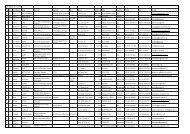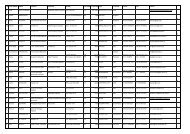icvg 2009 part I pp 1-131.pdf - Cornell University
icvg 2009 part I pp 1-131.pdf - Cornell University
icvg 2009 part I pp 1-131.pdf - Cornell University
Create successful ePaper yourself
Turn your PDF publications into a flip-book with our unique Google optimized e-Paper software.
— 43 —<br />
Complete sequencing of GVQ isolate from muscadine<br />
revealed bicistronic, polyadenilated genome with the<br />
organization resembling marafiviruses. The larger ORF<br />
contained conserved domains of typoviral<br />
methyltransferase, protease/endopeptidase, helicase, RdRp,<br />
and tymoviral coat proteins in the amino-to-carboxy<br />
direction. The second, nested, ORF codes for a putative<br />
protein with an estimated molecular mass of 27 kDa and a<br />
possible role in virus movement within the host.<br />
Pairwise comparisons with known tymovirids showed<br />
identity levels far below the species demarcation threshold<br />
indicating that the virus from muscadines is indeed an<br />
undescribed species. In phylogenetic analyses, GVQ always<br />
grouped with marafiviruses, forming a deeply rooted and a<br />
separate lineage clustering with GRVFV.<br />
Permuted RdRp motifs. Detailed analyses of GVQ<br />
RdRP in all isolates showed an insertion of 21 amino acids<br />
(63 nucleotides) comprising a hallmark tripeptide GDD<br />
upstream of motif A. In a series of independent<br />
experiments, we proved that this sequence arrrangement is<br />
not an artifact due to RT/cloning, but a natural phenomenon<br />
reminiscent of the internal permutation observed recently in<br />
a few +ssRNA insect viruses and dsRNA birnaviruses<br />
(Gorbalenya et al., 2002). Direct comparison of RdRps<br />
between GVQ and TaV/EeV showed conservation of the<br />
palm sub-domain based motifs C, A and B, thus further<br />
proving that these viruses have similar, non-canonical<br />
organization. This is the first report on permuted<br />
organization of RdRp motifs in plant viruses (and in<br />
alphavirus-like viruses in general).<br />
However, comparative sequence analyses did not<br />
reveal any <strong>part</strong>icular evolutionary affinity between GVQ<br />
and TaV/EeV/birnaviruses. Consequently, a common<br />
ancestral event as the source of permutations observed in<br />
GVQ and TaV/EeV/birnaviruses a<strong>pp</strong>ears unlikely.<br />
Functionally, the permutation may confer unique properties<br />
to RdRp. Using IBDV RdRp as a model, it was shown that<br />
this enzyme compared to canonical RdRps has a unique<br />
profile of stimulation by cobalt ions (Letzel et al., 2007).<br />
GVQ distribution and diversity. RT-PCR-based survey<br />
carried out primarily on native Vitis germplasm in the<br />
Southeastern US in 2008, revealed the presence of GVQ in<br />
several muscadine samples as well as in Vitis aestivalis and<br />
in Vitis vinifera of an unknown cultivar. Surprisingly, GVQ<br />
was also found in one accession of native blackberry<br />
(Rubus canadensis) in the Great Smoky Mountains<br />
National Park.<br />
Cloned RdRp and CP sequences of different GVQ<br />
isolates showed limited variation in both genomic<br />
segments. Curiously, the isolate from Vitis aestivalis<br />
a<strong>pp</strong>eared closer to blackberry than to other grape isolates.<br />
Furthermore, direct comparisons showed that the GFkV 416<br />
(Shi et al., 2003) is indeed an isolate of GVQ, and not an<br />
“unusual” variant of GFkV. Additionally, while depositing<br />
our sequence data in the NCBI/GenBank prior to<br />
submitting a full manuscript to the publisher (Sabanadzovic<br />
et al., in press), we noticed the recent release of genomic<br />
data of the virus denoted Grapevine Syrah virus 1 with an<br />
associated publication available on-line (Al Rwahnih et al.,<br />
<strong>2009</strong>). Surprisingly, GVQ shared 98% identical sequences<br />
with the virus from cv. Syrah indicating they belong to the<br />
same taxon. Due to contemporary and independent<br />
discoveries, we decided to keep the generic name<br />
Grapevine virus Q which reflects the range of botanical<br />
species across the genus Vitis we found as hosts of this<br />
virus. However, the non-canonical order of RdRp motifs<br />
and GSyV-1 relationship to GFkV 416 were not<br />
reported/commented in the paper of Al Rwahnih et al.<br />
In conclusion, GVQ (syn. GSyV-1, GFkV 416 ) is an<br />
unusual tymovirid characterized by internally permuted<br />
motifs of RdRp, a rare phenomenon across the RNA virus<br />
world not previously reported in plant viruses. GVQ<br />
a<strong>pp</strong>ears rather widespread in native American grape<br />
germplasm and represents the first virus from the family<br />
Tymoviridae to infect both Rubus and Vitis s<strong>pp</strong>. It is<br />
intriguing to see if single GVQ infections in Vitis rupestris<br />
provoke vein-associated symptomatic responses, as in the<br />
case of related viruses (GFkV, GAMaV and GRVFV).<br />
LITERATURE<br />
AL RWAHNIH, M., DAUBERT, S., GOLINO, D. & ROWHANI A.<br />
<strong>2009</strong>. Deep sequencing analysis of RNAs from a grapevine showing<br />
Syrah decline symptoms reveals a multiple virus infection that<br />
includes a novel virus. Virology. doi:10.1016/j.virol.<strong>2009</strong>.02.028<br />
DREHER, T.W., EDWARDS, M.C., GIBBS, A.J., HAENNI, A-L.,<br />
HAMMOND, R.W., JUPIN, I., KOENIG, R.,<br />
SABANADZOVIC, S., ABOU GHANEM-SABANADZOVIC, N.<br />
& MARTELLI, G.P. 2005. Family Tymoviridae, in Fauquet, C.M.,<br />
Mayo, M., Maniloff, J., Desselberger, U., L.A. Ball (Eds.) Virus<br />
Taxonomy (Eight Report of the ICTV). Elsevier/Academic Press,<br />
London <strong>pp</strong> 1061-1074<br />
GOLDBACH, R., LE GALL, O. & WELLINK, J. 1991. Alpha-like<br />
viruses in plants. Seminars in Virology 2, 19–25.<br />
GORBALENYA, A.E., PRINGLE, F.M., ZEDDAM, J.L., LUKE,<br />
B.T., CAMERON, C.E., KALMAKOFF, J., HANZLIK, T.N.,<br />
GORDON, K.H. & WARD, V.K. 2002. The palm subdomainbased<br />
active site is internally permuted in viral RNA-dependent<br />
RNA polymerases of an ancient lineage. Journal of Molecular<br />
Biology 324, 47–62.<br />
KATSUMA, S., TANAKA, S., OMURO, N., TAKABUCHI, L.,<br />
DAIMON, T., IMANISHI, S., YAMASHITA, S., IWANAGA,<br />
M., MITA, K., MAEDA, S., KOBAYASHI, M. & SHIMADA, T.<br />
2005. Novel macula-like virus identified in Bombyx mori cultured<br />
cells. Journal of Virology 79, 5577-5584<br />
KOONIN, E.V. 1991. The phylogeny of RNA-dependent RNA<br />
polymerases of positive-strand RNA viruses. Journal of General<br />
Virology 72, 2197–2206.<br />
LETZEL, T., MUNDT, E. & GORBALENYA, A.E. 2007. Evidence for<br />
functional significance of the permuted C motif in Co 2+ -stimulated<br />
RNA dependent RNA polymerase of infectious bursal disease virus.<br />
Journal of General Virology 88, 2824-2833.<br />
MARTELLI, G.P., SABANADZOVIC, S., ABOU-GHANEM<br />
SABANADZOVIC, N., EDWARDS & M.C., DREHER, T. 2002.<br />
The family Tymoviridae. Archives of Virology 147, 1837–1846.<br />
POCH, O., SAUVAGET, I., DELARUE, M. & TORDO, N. 1989.<br />
Identification of four conserved motifs among the RNA-dependent<br />
polymerase encoding elements. EMBO Journal 8, 3867–3874.<br />
SABANADZOVIC, S., ABOU-GHANEM, N., CASTELLANO, M.A.,<br />
DIGIARO, M. & MARTELLI, G.P. 2000. Grapevine fleck viruslike<br />
viruses in Vitis. Archives of Virology 145, 553-565.<br />
SABANADZOVIC, S. & ABOU GHANEM-SABANADZOVIC, N.<br />
<strong>2009</strong>. Identification and molecular characterization of a first<br />
marafivirus in Rubus s<strong>pp</strong>. Archives of Virology (in press).<br />
SHI, B.J., HABILI, N. & SYMONS, R.H. 2003. Nucleotide sequence<br />
variation in a small region of the Grapevine fleck virus provides<br />
evidence for two sequence variants of the virus. Annals of A<strong>pp</strong>lied<br />
Biology 142, 349-355.<br />
Progrès Agricole et Viticole, <strong>2009</strong>, Hors Série – Extended abstracts 16 th Meeting of ICVG, Dijon, France, 31 Aug – 4 Sept <strong>2009</strong>




